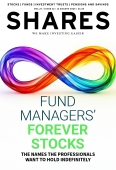Archived article
Please note that tax, investment, pension and ISA rules can change and the information and any views contained in this article may now be inaccurate.
Why volatility isn’t just a mental drain but a money drain too

A year of tariff drama and currency concerns have led many investors to start to look outside the US to boost their market returns. And while some have steered towards calmer waters, with a boost in European investments, others have turned towards emerging markets.
While both can offer their own set of perks to a portfolio, those looking at rockier markets have an extra consideration to factor into returns: Even when high highs and low lows seem to average out, what are these peaks and troughs actually doing to the value of the investment?
It seems intuitive enough to think that if an investment goes down by 5% one year, and then up by 10% the next, then you would still be achieving a decent gain, because you’d end up being up 5% overall right? Unfortunately for investors it doesn’t work that way.
If you have £100 in the stock market and it loses 5% in a year, at the end of that year you’d be left with £95. The next year, if your investment gains 10%, your money will not increase to £105. Instead, it will be a 10% gain on £95, which is £104.50.
In this example, there’s a very minimal difference between the amount that an annual average would assume your investment has grown to, and the amount it actually is. But this 50 pence difference can become significant quickly.
THE TORTOISE AND THE HARE: UK VS BRAZIL
The effects of volatility drag become much more apparent when looking at the long-term outcome in different markets. Take two very different economies, the slow-but-steady UK and the volatile Brazil.
In the past 10 calendar years, the annual return from each year of the FTSE 100 averages out to 6.7%, while the MSCI Brazil averages to 8.8% in sterling. Based on these averages, £1,000 put into the FTSE 100 would increase to £1,950.60 while in MSCI Brazil, this would become £2,403*. That’s almost a £500 difference.
But how did money in these markets perform in reality, not when using averages? The £1,000 in the FTSE 100 turned into £1,825, still a drop from the averaged-out gains, but within the same range. However, the £1,000 in MSCI Brazil turned into £1,347*. Not only a £1,000 difference from the starting amount, but less of a gain than the FTSE 100, despite having a significantly higher annual average gain.
When looking at the percentage changes year by year, the numbers begin to add up. While the FTSE 100 still had some volatility, losing 1.3% in the first year to a gain of 11.95% in the second year, this was nothing compared to the range of MSCI Brazil, which plummeted 38% in the first year, to increase by 98% in the second year.
This 98% gain dragged the average annual return up significantly, but because it happened right after the investment had lost over a third of its value, the gains were on a much smaller pot of money than that initial £1,000.
MODELLING RETURNS
Fortunately, when many fund managers show annualised returns, they use a geometric mean, rather than a typical arithmetic mean, to reach the percentage. This allows for a much more representative value of what has happened to the investment. Instead of summing the values and dividing by the number of values, for a geometric mean the values are multiplied together, and then this figure is taken to the root of the amount of numbers in the set.
So, to take the geometric average of values A, B, and C, you would multiply A*B*C, and then take the cube root of that result, since there are three values in the set. Notably, you cannot use negative numbers when calculating a geometric mean. Instead, you must create a proportion.
In the case of the decrease of 38% for Brazil, instead of multiplying by negative 38, you would subtract 0.38 from 1, to reach a value of 0.62. Then, you would multiply by 0.62 in your calculation.
FACTORING VOLATILITY DRAG INTO PORTFOLIOS
When creating a portfolio, it’s a common practice to attempt to build a return that is relatively stable overtime. This strategy is often chalked up to peace of mind: If the return on a portfolio is smooth, investors can remain calm and are less likely to pull money out of the market, which can lead to large losses. This is certainly an important factor, but it’s not the only benefit of steady returns.
The other advantage is the mathematical upside. If a portfolio has a large downside risk, the returns it will need to create to make up for those market falls are extreme. It’s impossible to find a market that will not have some negative periods but minimising how extreme those troughs are can make achieving strong returns significantly easier.
A helpful way to create a clear picture of how a market has actually performed is looking at the return of an actual amount of money, like £1,000, over a period, instead of relying on averages. While this will not capture elements such as fees, it will give a decent impression of how an investment has performed in reality.
*Figures do not factor in investment or platform fees, data from FE Analytics
Important information:
These articles are provided by Shares magazine which is published by AJ Bell Media, a part of AJ Bell. Shares is not written by AJ Bell.
Shares is provided for your general information and use and is not a personal recommendation to invest. It is not intended to be relied upon by you in making or not making any investment decisions. The investments referred to in these articles will not be suitable for all investors. If in doubt please seek appropriate independent financial advice.
Investors acting on the information in these articles do so at their own risk and AJ Bell Media and its staff do not accept liability for losses suffered by investors as a result of their investment decisions.
Issue contents
Exchange-Traded Funds
Feature
Great Ideas
News
- Eli Lilly shares under pressure after disappointing clinical trial results
- Recruiter Hays set to update expectations with shares at decade-low
- Record numbers of US companies are beating revenue and earnings forecasts
- Fresnillo up 180% year-to-date after latest strong results
- All eyes on second-quarter retail bellwether Walmart
- Bellway brings a ray of light to the housebuilders with its half-year update
 magazine
magazine








